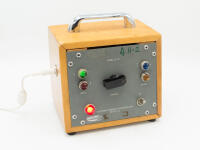What is it?
In the domain of electronics, there’s a standard piece of equipment: a “signal generator,” which continuously outputs a sine wave, square wave, or other standard signal. (It’s used with other gear for a wide range of useful purposes.)
The signals output by these devices are very generic and standard, and don’t really encode information, per se. I wondered what an equivalent piece of gear would look like if it was outputting the most important piece of information—the human genome.
This device, styled as if it were prototype lab equipment and set in a real vintage lab-gear wooden enclosure, contains the 6.2-gigabase-pair human genome and continuously outputs it with flashing lights: A and T on the left, G and C on the right.
The knob adjusts its speed. Should you wave your hand near the metal handle, the lights glow more brightly as it senses your presence.
It selects a random passage of the genome at startup and marches through it until the end, then picks another starting place.



